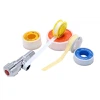Although they look, feel, and might even taste similar (we haven't tasted it before... or have we?), they aren't rated for the same thing. This is because the chemical compound PFTE (polytetrafluoroethylene) found in gas fitters' tape is much denser than plumbers' tape, which doesn't allow the gas to permeate through.
SO, HOW CAN YOU TELL THE DIFFERENCE BETWEEN GAS FITTERS' TAPE AND PLUMBERS' TAPE?
Different Coloured Pipe Sealant Tapes and Uses in America
Oftentimes, PFTE tapes shipped from the US will be categorized by colours that indicate what jobs they're used for:
Yellow tape will be rated for a proper gas sealant.
White tape is used for plumbing and liquid sealing.
Red tape has triple density thickness and is used for larger diameter pipes (two inches) and larger joints found in distribution systems (for example, a water distribution system found in commercial buildings). Side note: you may be thinking that using a thicker tape would be better, because if it's rated for big projects like mass distribution in a high rise, it'll be even better on your homes natural gas line. Well, you'd be wrong. Using red tape on your homes 1/2 or 3/8 inch gas fittings will result in a poor connection, as the fittings wouldn't be able to screw on together properly.
Lastly, green tape is designed for pipes carrying oxygen and is very seldom used in residential projects.
HOW TO APPLY GAS FITTERS' TAPE TO YOUR GAS LINE CONNECTION
First and foremost, never try to squeeze gas fitters tape into the female end of a threaded pipe. Doing this is difficult and counter-intuitive, but somehow people still try this and ruin their gas line in the process. Now that we established that the logical way to assemble your gas line is the best way to do it... let's get started.
All cheekiness aside, here is the step-by-step process to properly apply gas fitters' tape and safely assemble your gas line.
Take your male gas fitting and wrap your gas fitters' tape 2-3 times around the threads. Be sure to wrap it nice and neatly, without any creases or folds in the tape.
Next, gently push the tape into the threads, just to get rid of any air between the layers. You can also lightly press your thumb or finger on the gas tape while wrapping it around the threads. Do not attempt to squish the tape into the crevasses of the threads.
Now, gently and evenly twist the female gas fitting onto the male gas fitting.
Lastly, take two crescent wrenches and twist the male and female gas fittings in opposite directions to tighten the connection. This last part is an essential practice of gas fitting and ensuring your connection is done the right way. Using just a single crescent wrench, even if you can get the connection nice and tight, can put strain on the pipes or hose that the fittings are connected to, as you would be twisting it. Using two wrenches ensures the components on either end of the connection stay in place.
Be sure to always leak test your connection. This step is vital because even the best of the best aren't perfect every time they do this. You always want to catch a potential gas leak as soon as you can before it becomes a problem, and in this case it's right after you attach your gas line connections.
There you have it. You've learned the difference between plumbers' tape and gas fitters' tape, and how to apply them to your threaded connections.










